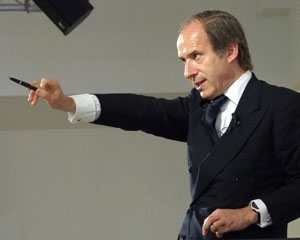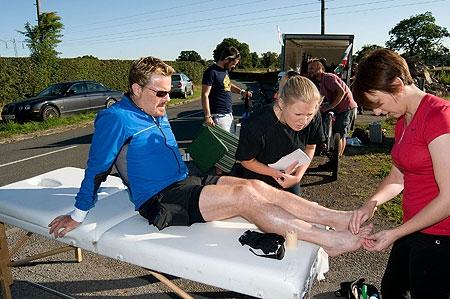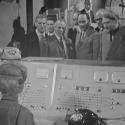Is Eddie Izzard running a lot of marathons really worth three hour-long documentaries? No, but it was worth watching this first one. Having seen close personal friends gearing up to run the London Marathon, a process involving months of training sessions and muscle-group-specific workouts, it was barely believable to see a patently un-honed Izzard strolling into the Olympic Medical Institute in Eddie Izzard: Marathon Man, confessing that “I’ve run before, mainly for buses,” and proposing to run 1,100 miles round the UK in a month’s time. Specifically, he aimed to run 43 marathons in 51 days for Sport Relief. The Institute’s fitness boffins couldn’t believe it either.
Tests revealed that Izzard scored pretty well for stamina, but had flat feet, a string of previous injuries liable to flare up under pressure, and a stocky body shape not optimised for distance-running. Weirdly, none of this seemed to bother him much. Professor Greg Whyte signed on as Eddie’s personal trainer, and he seemed to hit the nail on the head with his comment that attitude was as crucial as physical aptitude in sporting challenges of this nature. Before long, as he flogged his way out of London towards Staines, Basingstoke and Devizes, Izzard was also discovering the truth of the Prof’s observation that “being a competitive athlete is fundamentally miserable.” Thudding along endless stretches of tarmac in pouring rain, Izzard was suffering man-sized doses of that loneliness synonymous with long distance runners.
After forcing his creaking body to grind out those marathon-sized miles, he had to undergo agonising bouts of post-match therapy with Jo, his sports therapist, as she drained fluid from his hideous array of blisters. There is, we gathered, something called an “IT band”, a chunk of fibrous tissue running down the outside of the leg. Eddie’s had become inflamed, and Jo’s massages had him biting pillows in anguish.
Naturally there was plenty of acting involved, and Izzard was happy to play along with psychobabbling analyses of his motives for undertaking such a reckless stunt. One of his key objectives was to run to Skewen in South Wales, and to revisit the house where he lived in 1968 when his mother died. As Matthew Parris pointed out in his Radio Times interview with Izzard, he’s terribly serious for a comedian (“almost off-puttingly earnest”, in fact). We saw this vividly in Izzard’s ability to run while voicing aloud the theory that he was trying to get back to the idyllic childhood he experienced before the Reaper intervened. But, even if his pace was incredibly slow and he kept stopping to drink beer, eat ice-cream and watch the ducks on a nearby pond, you had to admire his bloody-minded obstinacy.
 The motivations of celebrity auctioneer and Swiss baron Simon de Pury (pictured right) were more difficult to read in The Man with the Golden Gavel. The Evening Standard’s art critic Godfrey Barker, who appears to have inherited both his job and his elaborately tooled accent from Brian Sewell, raved about how de Pury was “just so towering an actor”, so much so that one couldn’t differentiate the character he played from the man himself. Yet film of de Pury, owner and chief auctioneer of Phillips auction house, as he cajoled bids from his morbidly wealthy clientele, failed to bear this out. The problem was that the credit crunch arrived in the midst of director Malcolm Neaum’s shooting schedule, leaving de Pury stranded as the pecuniary tide went out.
The motivations of celebrity auctioneer and Swiss baron Simon de Pury (pictured right) were more difficult to read in The Man with the Golden Gavel. The Evening Standard’s art critic Godfrey Barker, who appears to have inherited both his job and his elaborately tooled accent from Brian Sewell, raved about how de Pury was “just so towering an actor”, so much so that one couldn’t differentiate the character he played from the man himself. Yet film of de Pury, owner and chief auctioneer of Phillips auction house, as he cajoled bids from his morbidly wealthy clientele, failed to bear this out. The problem was that the credit crunch arrived in the midst of director Malcolm Neaum’s shooting schedule, leaving de Pury stranded as the pecuniary tide went out.
Still, Neaum successfully evoked a world where familiar laws of logic and common sense had ceased to apply. De Pury’s fetish is for “wet art”, or new works by cutting-edge artists. This may mean Damien Hirst pieces which sell for £4million, or a bin full of motorised garbage by New York “urban artist” David Ellis (“I see great commercial potential,” de Pury exclaimed), or a small ball of “fecal matter” from Tom Friedman. De Pury sold this last artefact for $42,000, but as the commentary noted, “that was before the bottom fell out of the market.”
As the financial slump ground on, things kept getting bleaker, though seeing the kind of people who inhabit de Pury’s world, this seemed nothing more than healthy natural selection. With sales falling by 90 per cent, de Pury had to be propped up by a group of hatchet-faced Russian investors, and even his pioneering line in hideous plastic toys, including a plastic killer tomato and a purple Godzilla, had to be axed. Yet he remained remarkably cheerful – he’s probably got millions stashed away in Zurich, after all – and has diversified into reality TV and a bit of DJ’ing. “Of course the sun is going to come back at some stage,” he bubbled. In this particular case, do we really give a...?















Add comment